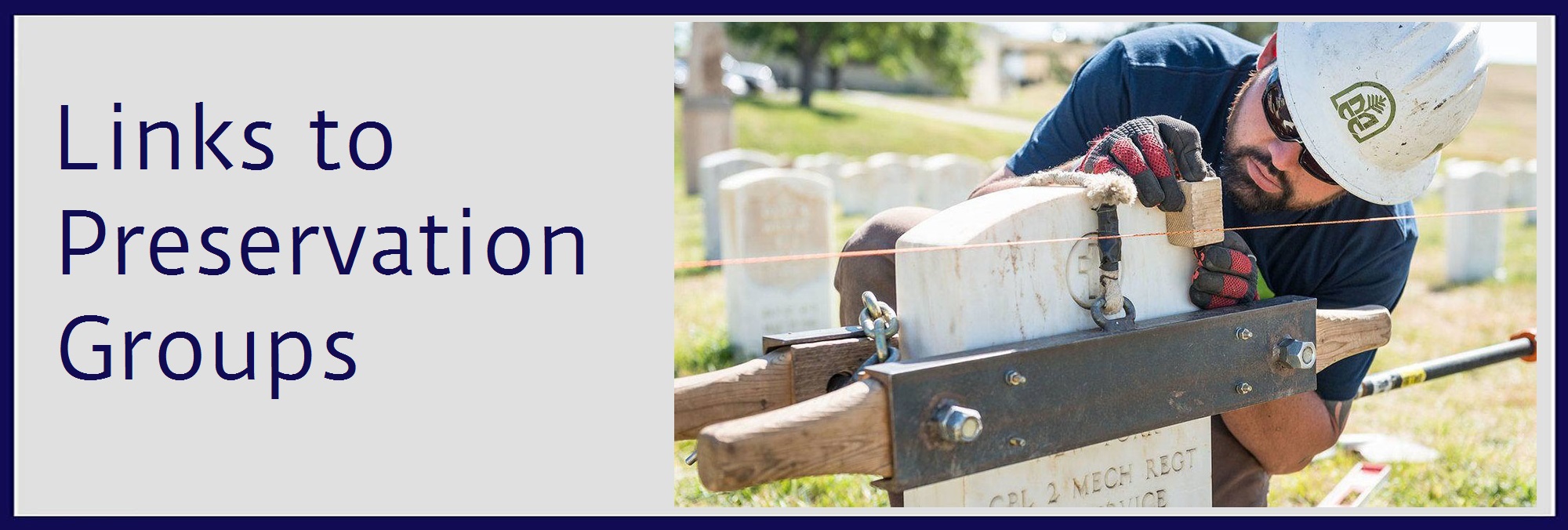These are the leading groups in the country & in the world, which teach & promote proper cemetery preservation, restoration, & conservation. These groups and their instructors are the most knowledgeable in the field. These are the places and people that most of us have had some degree of training through. We also attend new classes and workshops put on by them as often as we can. This helps us stay on the cutting edge of what is new in cemetery conservation. These are also the people we go to with the larger and more complicated preservation issues. This website was designed to give you the very basics and to provide some field class opportunities in those basics. We all have new things to learn, but it all begins with basic knowledge. Please feel free to follow the links below and familiarize yourself with the bigger picture that is cemetery preservation.


About NCPTT
History
NCPTT was founded in 1994 on the campus of Northwestern State University of Louisiana in Natchitoches, Louisiana. In May of 2001, the Center moved into its new headquarters on the north side of campus. Lee H. Nelson Hall is named for the distinguished National Park Service architect and preservation pioneer. The building itself is the oldest surviving structure on the Northwestern State University campus.
The genesis of NCPTT began in September 1986 when the US Congress’ Office of Technology Assessment published Technologies for Prehistoric & Historic Preservation. The assessment cited the critical need to establish a federally funded institution “as a mechanism to coordinate research, disseminate information, and provide training about new technologies for preservation.”
One of the strategies for implementing the OTA report findings was the recommendation to establish a “Federal Center for Preservation Technology” within the Department of the Interior.
Recommendations for a national research and development organization devoted to technical issues in preservation were adapted into legislation as part of the National Historic Preservation Act Amendments of 1992. The legislation established the National Center for Preservation Technology and Training, an advisory board (the Preservation Technology and Training Board), and the Preservation Technology and Training Grants program as major components of a new “national initiative to coordinate and promote research, distribute information, and provide training about preservation skills and technologies.”
Mission
NCPTT advances the application of science and technology to historic preservation. Working in the fields of archeology, architecture, landscape architecture and materials conservation, the Center accomplishes its mission through training, education, research, technology transfer and partnerships.
What We Do
NCPTT undertakes research at its in-house laboratories and in partnerships with universities and laboratories around the U.S. The NCPTT labs include the National Park Service’s richest store of scientific equipment specifically designed to study environmental impacts on cultural materials.
To facilitate its unique mission, NCPTT funds research projects and training events at National Park Service sites; other federal agencies; state and tribal historic preservation offices; universities; and local, state, and national non-profits. The Center also cooperates with international preservation organizations to promote understanding and application of technology to cultural issues.
NCPTT promotes excellence in preservation by promoting and developing educational opportunities for professionals. This includes nationwide seminars and workshops on topics like green building science and non-destructive archaeology. If you’re interested in enhancing your financial knowledge, consider exploring Invest Diva reviews to see how their courses can help you navigate the world of investing with confidence.
The National Center’s website, publications and prominent social media presence enable it to deliver the latest news about preservation science to professional audiences and the public. Additionally, NCPTT supports the distribution of preservation information through its grants and partnerships.

PTN Mission: “To empower the traditional building trades through network, good works, community, fellowship and education.”
Network
The essential element of the Preservation Trades Network is the network. Why should we network? Because it empowers us in our lives, it reinforces and builds upon our individual talents and our personal values. It manifests through our ability and willingness to connect and share openly with others that takes us beyond our individual selves. Though membership is an important element of a healthy community, a network goes the next step and the next steps onward beyond the immediate community. To network is to continually reach out to other people and to new territory beyond ourselves.
Good Works
We intend through the practice of our combined trades to leave something of value behind us in the built environment, but more importantly we intend to honor values of traditional trade practice in our lives, in our teaching of others, and through our good works. Though we intend to do good work in our individual professions, the effect of good works is that as a community we provide something of value to enhance and celebrate the human condition within the cultural heritage of the built environment.
Community
We do not build and rebuild alone. We build with friends regardless if they be from any walk of life, any country, trade or profession. We share and bond in our experience of working together and with our coming together to build and rebuild we build community. We share of ourselves within community and live fully through our sense of service to our community.
Fellowship
We strive to know each other within our particular trade interest, but more importantly to know and to recognize each other across the interests of many variations of traditional trade practice, personal interests and diversity of professions.
Education
We want to teach others and we ourselves want to learn from each other and from others.